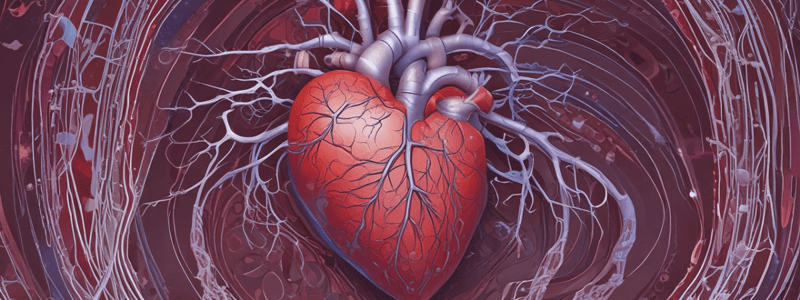Podcast
Questions and Answers
What is the most common cause of ischemic heart disease?
What is the most common cause of ischemic heart disease?
- Embolus
- Tachycardia
- Atherosclerotic plaques in the coronary vessels (correct)
- Vasospasms
Which of the following is NOT a risk factor for coronary atheroma?
Which of the following is NOT a risk factor for coronary atheroma?
- Ethanol
- Increased HDL (correct)
- Age > 65 years
- BMI > 30
What type of angina occurs due to a stable atherosclerotic plaque?
What type of angina occurs due to a stable atherosclerotic plaque?
- Stable angina (correct)
- STEMI
- NSTEMI
- Unstable angina
What is the duration of ischemia required to lead to infarction?
What is the duration of ischemia required to lead to infarction?
What type of infarction occurs due to complete occlusion of the blood vessel lumen?
What type of infarction occurs due to complete occlusion of the blood vessel lumen?
What is the characteristic of ischemic cardiac chest pain?
What is the characteristic of ischemic cardiac chest pain?
What is the typical duration of ischemic cardiac chest pain?
What is the typical duration of ischemic cardiac chest pain?
What is NOT a characteristic of ischemic cardiac chest pain?
What is NOT a characteristic of ischemic cardiac chest pain?
What is a characteristic of atypical chest pain in myocardial infarction?
What is a characteristic of atypical chest pain in myocardial infarction?
What is a common feature of right ventricular myocardial infarction?
What is a common feature of right ventricular myocardial infarction?
What is a complication of myocardial infarction that can occur within 24 hours?
What is a complication of myocardial infarction that can occur within 24 hours?
What is a characteristic of pericarditis?
What is a characteristic of pericarditis?
What is a complication of myocardial infarction that can occur between 3-14 days?
What is a complication of myocardial infarction that can occur between 3-14 days?
What is a characteristic of left ventricular myocardial infarction?
What is a characteristic of left ventricular myocardial infarction?
What is a characteristic of atypical chest pain in myocardial infarction in diabetes mellitus?
What is a characteristic of atypical chest pain in myocardial infarction in diabetes mellitus?
What is a complication of myocardial infarction that can occur after 14 days?
What is a complication of myocardial infarction that can occur after 14 days?
Flashcards are hidden until you start studying
Study Notes
Ischemic Heart Disease
- Ischemic heart disease is caused by a reduced oxygen supply to the heart, often due to atherosclerotic plaques in the coronary vessels, embolus, or vasospasms.
- Increased oxygen demand can also contribute to ischemic heart disease, triggered by factors such as tachycardia, left ventricular hypertrophy, or exertion.
Risk Factors for Coronary Atheroma
- Modifiable risk factors:
- BMI > 30
- Diabetes mellitus
- Hypertension
- Tobacco use
- Increased LDL/decreased HDL
- Ethanol consumption
- Non-modifiable risk factors:
- Age > 65 years
- Relatives with CAD/family history
Classifications of Ischemic Heart Disease
- Stable angina:
- Caused by stable atherosclerotic plaques
- Pain occurs during exertion
- Subendocardial ischemia
- Unstable angina:
- Caused by plaque rupture and thrombus formation
- Pain occurs at rest or progresses rapidly over a short period
- Subendocardial ischemia
- Subendocardial infarction (NSTEMI):
- Ischemia for longer than 30 minutes leads to infarction (cell death)
- Pain occurs at rest or progresses rapidly over a short period
- Subendocardial infarction
- Transmural infarction (STEMI):
- Complete occlusion of blood vessel lumen and infarct of the entire thickness of the myocardium
- Pain occurs at rest or progresses rapidly over a short period
- Transmural infarction
Clinical Features of Ischemic Cardiac Chest Pain
- Typical:
- Discomfort/pressure (dull, crushing) lasting > 2 minutes
- Provoked by activity/exercise
- Radiation (arms, jaws)
- Does not change with respiration/position
- Associated with sweating/nausea
- Relieved by rest/nitroglycerin
- Atypical:
- Pain localised with one finger
- Constant pain lasting for a few days
- Fleeting pains lasting for a few seconds
- Pain reduced by movement/palpation
- No pain (diabetes mellitus, elderly, post heart transplant)
Pathophysiology and Clinical Features
- Right ventricular MI:
- Jugular venous distension
- Oedema (lower extremities)
- Hepatomegaly
- Ascites
- Hypotension
- Clear lungs
- Bradycardia/AV block
- Left ventricular MI:
- Pulmonary oedema
- Shortness of breath
- Hypotension
- S4 heart sound
- Reflex tachycardia
MI Complications
- 0-24 hours:
- Sudden cardiac death
- Acute heart failure
- 24 hours-3 days:
- Pericarditis
- Inflammation
- Frictional rub
- Pericardial effusion
- 3-14 days:
- Rupture syndromes
- Ventricular septal defect
- Free wall rupture -> cardiac tamponade
- Papillary muscle rupture -> mitral regurgitation
- 14 days-months:
- LV aneurysms
- Risk of thrombus formation
Pericarditis
- Inflammation of the pericardium often due to a viral illness
- Causes retrosternal, sharp, and localised chest pain
- A pericardial rub may be heard on auscultation of the chest
- Saddle-shaped ST elevations may be present in an ECG
Studying That Suits You
Use AI to generate personalized quizzes and flashcards to suit your learning preferences.





